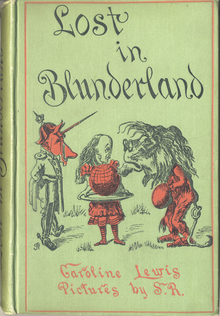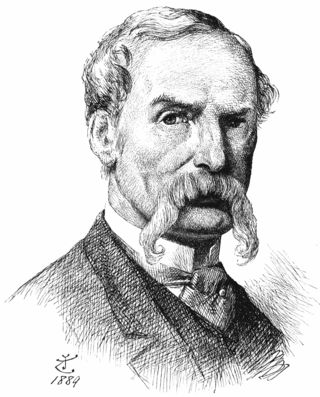
Sir John Tenniel was an English illustrator, graphic humourist and political cartoonist prominent in the second half of the 19th century. An alumnus of the Royal Academy of Arts in London, he was knighted for artistic achievements in 1893, the first such honour ever bestowed on an illustrator or cartoonist.

Through the Looking-Glass, and What Alice Found There is a novel published on 27 December 1871 by Lewis Carroll, a mathematics professor at the University of Oxford, and the sequel to Alice's Adventures in Wonderland (1865). Alice again enters a fantastical world, this time by climbing through a mirror into the world that she can see beyond it. There she finds that, just like a reflection, everything is reversed, including logic.

Alice's Adventures in Wonderland is an 1865 English novel by Lewis Carroll, a mathematics professor at Oxford University. It details the story of a young girl named Alice who falls through a rabbit hole into a fantasy world of anthropomorphic creatures. It is seen as an example of the literary nonsense genre. The artist John Tenniel provided 42 wood-engraved illustrations for the book.
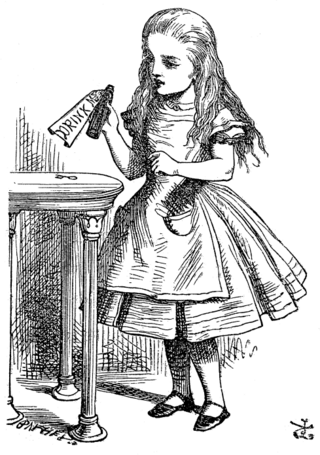
Alice is a fictional character and the main protagonist of Lewis Carroll's children's novel Alice's Adventures in Wonderland (1865) and its sequel, Through the Looking-Glass (1871). A child in the mid-Victorian era, Alice unintentionally goes on an underground adventure after falling down a rabbit hole into Wonderland; in the sequel, she steps through a mirror into an alternative world.

Alice Pleasance Hargreaves was an English woman who, in her childhood, was an acquaintance and photography subject of Lewis Carroll. One of the stories he told her during a boating trip became the children's classic 1865 novel Alice's Adventures in Wonderland. She shared her name with "Alice", the heroine of the story, but scholars disagree about the extent to which the character was based upon her.

The Cheshire Cat is a fictional cat popularised by Lewis Carroll in Alice's Adventures in Wonderland and known for its distinctive mischievous grin. While now most often used in Alice-related contexts, the association of a "Cheshire cat" with grinning predates the 1865 book. It has transcended the context of literature and become enmeshed in popular culture, appearing in various forms of media, from political cartoons to television, as well as in cross-disciplinary studies, from business to science. One distinguishing feature of the Alice-style Cheshire Cat involves a periodic gradual disappearance of its body, leaving only one last visible trace: its iconic grin. He belongs to the Duchess.

Tom Hood was an English humorist, playwright and author. He was the son of the poet and author Thomas Hood. Pen and Pencil Pictures (1857) was the first of his illustrated books. His most successful novel was Captain Master's Children (1865).
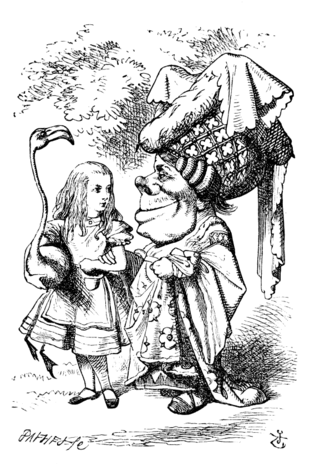
The Duchess is a character in Lewis Carroll's Alice's Adventures in Wonderland, published in 1865. Carroll does not describe her physically in much detail, although as stated in Chapter 9, "Alice did not much like keeping so close to her: first, because the Duchess was very ugly; and secondly, because she was exactly the right height to rest her chin upon Alice’s shoulder, and it was an uncomfortably sharp chin." Her hideous appearance and short stature is strongly established in the popular imagination thanks to John Tenniel's illustrations and from context it is clear that Alice finds her quite unattractive.

Lewis Carroll's books Alice's Adventures in Wonderland (1865) and Through the Looking-Glass (1871) have been highly popular in their original forms, and have served as the basis for many subsequent works since they were published. They have been adapted directly into other media, their characters and situations have been appropriated into other works, and these elements have been referenced innumerable times as familiar elements of shared culture. Simple references to the two books are too numerous to list; this list of works based on Alice in Wonderland focuses on works based specifically and substantially on Carroll's two books about the character of Alice.

Edward Harold Begbie, also known as Harold Begbie, was an English journalist and the author of nearly 50 books and poems. Besides studies of the Christian religion, he wrote numerous other books, including political satire, comedy, fiction, science fiction, plays and poetry. He died in London on 8 October 1929.

Automated Alice is a fantasy novel by British author Jeff Noon, first published in 1996. The book follows Alice's travels to a future Manchester city populated by Newmonians, Civil Serpents and a vanishing cat.
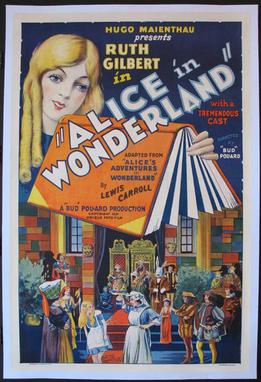
Alice in Wonderland (1931) is an independently made black-and-white Pre-Code American film based on Lewis Carroll's 1865 novel Alice's Adventures in Wonderland, directed by Bud Pollard, produced by Hugo Maienthau, and filmed at Metropolitan Studios in Fort Lee, New Jersey.
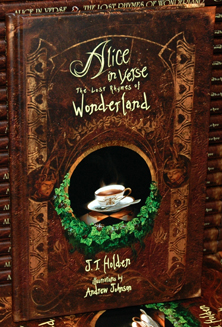
Alice in Verse: The Lost Rhymes of Wonderland (2010) is a reimagining of Lewis Carroll's 1865 novel Alice's Adventures in Wonderland written by British-American author J.T. Holden. It tells the story of Alice's Adventures in Wonderland in 19 rhyming poems, each written in the same style as Lewis Carroll's original verse. The book includes 36 illustrations by American artist Andrew Johnson.
J. T. Holden is an American author and poet of British descent, best known for his fluid use of rhyming poetry and clever syntax. His ambitious literary debut, Alice in Verse: The Lost Rhymes of Wonderland, offered a unique and refreshing take on Lewis Carroll's oft-adapted tale. Written entirely in rhyming verse, with a canny ear for Carroll's dialect, rhythm, and structure, the book follows Alice's Adventures in Wonderland.

Charles Lutwidge Dodgson, better known by his pen name Lewis Carroll, was an English author, poet and mathematician. His most notable works are Alice's Adventures in Wonderland (1865) and its sequel Through the Looking-Glass (1871). He was noted for his facility with word play, logic, and fantasy. His poems Jabberwocky (1871) and The Hunting of the Snark (1876) are classified in the genre of literary nonsense.

Clara in Blunderland is a novel by Caroline Lewis, written in 1902 and published by William Heinemann of London. It is a political parody of Lewis Carroll's two books, Alice's Adventures in Wonderland (1865) and Through the Looking-Glass (1871). The book was followed a year later by a sequel, Lost in Blunderland.
Lewis Carroll’s 1865 novel Alice's Adventures in Wonderland has been translated into 175 languages. The language with the most editions of the Alice in Wonderland novels in translation is Japanese, with 1,271 editions. Some translations, with the first date of publishing and of reprints or re-editions by other publishers, are:

Alice in Blunderland: An Iridescent Dream is a novel by John Kendrick Bangs. It was first published in 1907 by Doubleday, Page & Co. of New York, with illustrations by Albert Levering. It is a political parody of the two Alice books by Lewis Carroll, Alice's Adventures in Wonderland (1865) and Through the Looking-Glass (1871).

Rollo in Emblemland or Emblemland is a novel by John Kendrick Bangs, written in 1902 and published by R. H. Russell of New York. It is a tale inspired by the style of Lewis Carroll's 1865 book, Alice's Adventures in Wonderland.
Michael Henry Temple (1862–1928) was an English journalist and author. He is now known as the inventor of the chess variant Kriegspiel.
